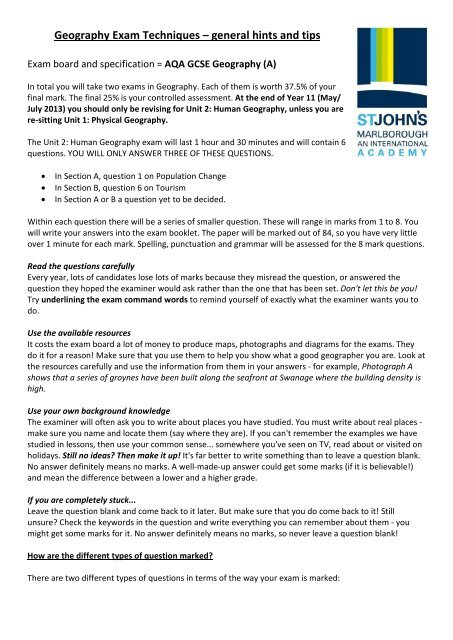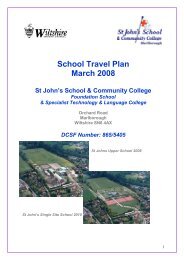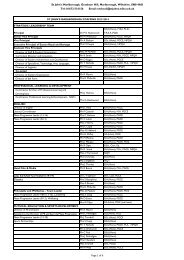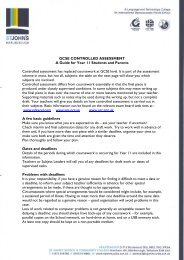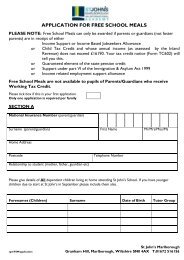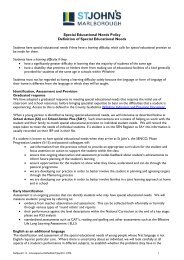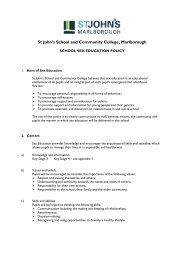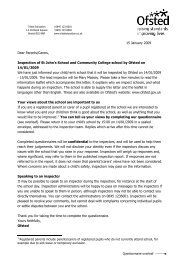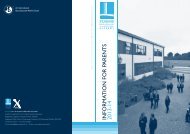Geography Exam Techniques â general hints and tips
Geography Exam Techniques â general hints and tips
Geography Exam Techniques â general hints and tips
You also want an ePaper? Increase the reach of your titles
YUMPU automatically turns print PDFs into web optimized ePapers that Google loves.
<strong>Geography</strong> <strong>Exam</strong> <strong>Techniques</strong> – <strong>general</strong> <strong>hints</strong> <strong>and</strong> <strong>tips</strong><br />
<strong>Exam</strong> board <strong>and</strong> specification = AQA GCSE <strong>Geography</strong> (A)<br />
In total you will take two exams in <strong>Geography</strong>. Each of them is worth 37.5% of your<br />
final mark. The final 25% is your controlled assessment. At the end of Year 11 (May/<br />
July 2013) you should only be revising for Unit 2: Human <strong>Geography</strong>, unless you are<br />
re-sitting Unit 1: Physical <strong>Geography</strong>.<br />
The Unit 2: Human <strong>Geography</strong> exam will last 1 hour <strong>and</strong> 30 minutes <strong>and</strong> will contain 6<br />
questions. YOU WILL ONLY ANSWER THREE OF THESE QUESTIONS.<br />
• In Section A, question 1 on Population Change<br />
• In Section B, question 6 on Tourism<br />
• In Section A or B a question yet to be decided.<br />
Within each question there will be a series of smaller question. These will range in marks from 1 to 8. You<br />
will write your answers into the exam booklet. The paper will be marked out of 84, so you have very little<br />
over 1 minute for each mark. Spelling, punctuation <strong>and</strong> grammar will be assessed for the 8 mark questions.<br />
Read the questions carefully<br />
Every year, lots of c<strong>and</strong>idates lose lots of marks because they misread the question, or answered the<br />
question they hoped the examiner would ask rather than the one that has been set. Don't let this be you!<br />
Try underlining the exam comm<strong>and</strong> words to remind yourself of exactly what the examiner wants you to<br />
do.<br />
Use the available resources<br />
It costs the exam board a lot of money to produce maps, photographs <strong>and</strong> diagrams for the exams. They<br />
do it for a reason! Make sure that you use them to help you show what a good geographer you are. Look at<br />
the resources carefully <strong>and</strong> use the information from them in your answers - for example, Photograph A<br />
shows that a series of groynes have been built along the seafront at Swanage where the building density is<br />
high.<br />
Use your own background knowledge<br />
The examiner will often ask you to write about places you have studied. You must write about real places -<br />
make sure you name <strong>and</strong> locate them (say where they are). If you can't remember the examples we have<br />
studied in lessons, then use your common sense... somewhere you've seen on TV, read about or visited on<br />
holidays. Still no ideas? Then make it up! It's far better to write something than to leave a question blank.<br />
No answer definitely means no marks. A well-made-up answer could get some marks (if it is believable!)<br />
<strong>and</strong> mean the difference between a lower <strong>and</strong> a higher grade.<br />
If you are completely stuck...<br />
Leave the question blank <strong>and</strong> come back to it later. But make sure that you do come back to it! Still<br />
unsure? Check the keywords in the question <strong>and</strong> write everything you can remember about them - you<br />
might get some marks for it. No answer definitely means no marks, so never leave a question blank!<br />
How are the different types of question marked?<br />
There are two different types of questions in terms of the way your exam is marked:
• Questions worth 1-3 marks are marked per correct point, so the more correct points you make the<br />
higher your mark will be.<br />
• Questions worth 4-8 marks will require longer answers!<br />
These answers are marked according to the 'level of response' that you give to the question. The examiner<br />
must first decide which level your answer falls into <strong>and</strong> then award you a mark within this level. If you do<br />
not meet the requirements of the higher level, the examiner cannot award you those marks. The higher<br />
your level, the higher your mark will be.<br />
Level 1: Basic<br />
Knowledge of basic information<br />
Simple underst<strong>and</strong>ing<br />
Few links; limited detail; uses a limited range of specialist terms<br />
Limited evidence of sentence structure<br />
Frequent spelling, punctuation <strong>and</strong> grammatical errors<br />
Level 2: Clear<br />
Knowledge of accurate information<br />
Clear underst<strong>and</strong>ing<br />
Answers have some linkages; occasional detail/exemplar; uses some specialist terms where appropriate<br />
Clear evidence of sentence structure<br />
Some spelling, punctuation <strong>and</strong> grammatical errors<br />
Level 3: Detailed<br />
Knowledge of accurate information appropriately contextualised <strong>and</strong>/or at correct scale Detailed<br />
underst<strong>and</strong>ing, supported by relevant evidence <strong>and</strong> exemplars<br />
Well organised, demonstrating detailed linkages <strong>and</strong> the interrelationships between factors Range of ideas<br />
in logical form; uses a range of specialist terms where appropriate<br />
Well structured response with effective use of sentences<br />
Few spelling, punctuation <strong>and</strong> grammatical errors<br />
Note: Your answer does not have to be perfect to score full marks. In fact, the mark scheme says that 'a<br />
perfect answer is not usually expected, even for full marks'.<br />
<strong>Exam</strong> comm<strong>and</strong> words<br />
Study = look very carefully at the resource - this is not a question that you have to answer but an<br />
instruction that needs to be followed before you answer the following questions. It is known as the stem<br />
part of the question.<br />
Complete = this might be filling in a table, finishing off a graph using data you have been given, choosing<br />
words from a list to fill in the missing gaps in a paragraph or circling the correct answer from a range of<br />
options. Make sure that you circle or tick the correct number of items!<br />
Name = just give the name - there is no need to write anything else e.g. Name the Oceans marked on the<br />
map at A <strong>and</strong> B. Just write 'Pacific Ocean <strong>and</strong> Atlantic Ocean' (or whatever they are!) not 'The ocean<br />
named on the map at A is the Pacific Ocean <strong>and</strong> the ocean named on the map at B is the Atlantic Ocean'.<br />
Label = this kind of question often asks you to add a name, description or explanation to a text-box on a<br />
photograph or diagram.<br />
Describe = say what you see (without giving reasons) - are there any patterns or trends? If you are<br />
describing a graph, make sure that you include figures in your answer.
Describe the location = say where something is - try to include distance <strong>and</strong> direction from other places<br />
e.g. Describe the location of Southampton. Southampton is a city in Hampshire, on the south-coast of<br />
Engl<strong>and</strong>. It is 25km north-west of Portsmouth <strong>and</strong> 40 km north-east of Bournemouth.<br />
Describe the distribution = say how something is spread out over space e.g. Describe the distribution of<br />
tropical storms. Tropical storms occur in warm oceans between the Tropics of Cancer <strong>and</strong> Capricorn, for<br />
example in the Bay of Bengal, the Arafuna Sea the Arabian Sea <strong>and</strong> the Caribbean Sea.<br />
Suggest the cause = give reasons for why something happened e.g. Suggest the cause of the earthquake in<br />
California. The Pacific Plate <strong>and</strong> North American Plate are moving past each other at a conservative margin.<br />
As they move, they snag <strong>and</strong> tension builds. A sudden movement sends out shock waves, which causes an<br />
earthquake.<br />
Explain / Give reasons / Suggest reasons = give reasons for why something happens <strong>and</strong> include all the<br />
specific detail as to why they lead to it happening; useful words to use in an 'explain' question include:<br />
therefore, so, because, as a result of, consequently, this means that.<br />
Give effects / Suggest impacts = this type of question asks you to look into the future <strong>and</strong> write about the<br />
consequences of something happening.<br />
Use examples = you must use real-life examples to gain full marks! You have studied a wide variety of<br />
examples in lessons. You can use your own <strong>general</strong> knowledge too. Make sure you give specific detail <strong>and</strong><br />
you include the name <strong>and</strong> location!<br />
Identify evidence / Use map evidence = this means that you must include information taken from the<br />
resources that you have been provided with. Don't forget to interpret the evidence that you give! E.g. Use<br />
map evidence to suggest why the area is vulnerable to coastal flooding. The l<strong>and</strong> is very flat <strong>and</strong> wet so if<br />
the sea broke through large areas would be flooded. I can tell that the l<strong>and</strong> is flat because the only contour<br />
line shown on the map extract is at 10 metres. The l<strong>and</strong> in squares 4126 <strong>and</strong> 4127 is 'Hempstead Marshes'.<br />
Great Moss Fen is in 4225 <strong>and</strong> 4226. Marshes <strong>and</strong> Fens are flat.<br />
Compare = describe the similarities <strong>and</strong> differences between things - words that will force you into a<br />
comparison are 'whereas' <strong>and</strong> 'in comparison to' 'alternatively' <strong>and</strong> 'on the other h<strong>and</strong>'; words ending in '-<br />
er' are also useful (eg. taller, richer, stronger); words such as 'less than' <strong>and</strong> 'more than' are also useful.<br />
Annotate = this means add labels to a diagram, photograph or map. Annotate questions will also ask you<br />
to do something else e.g. describe or explain. This additional comm<strong>and</strong> word tells you what type of<br />
statements to write in your annotations. When explaining, you will need to give detailed reasons. E.g.<br />
annotate the photograph to explain some of the possible impacts on the natural environment of a largescale<br />
tourist development in the area. New buildings may be on vegetation <strong>and</strong> destroy habitats meaning<br />
animal species may leave the area. Lots of sewage from new hotels may leak into the water, killing fish <strong>and</strong><br />
coral reefs. Large buildings may be an eyesore destroying the beauty of the area permanently.<br />
Revision guides<br />
The department recommends CGP GCSE <strong>Geography</strong> AQA A Revision guide because it is specific to the exam<br />
paper <strong>and</strong> exam board. This is sold by the school library.<br />
There are also work <strong>and</strong> answer booklets available to support the revision guide.


